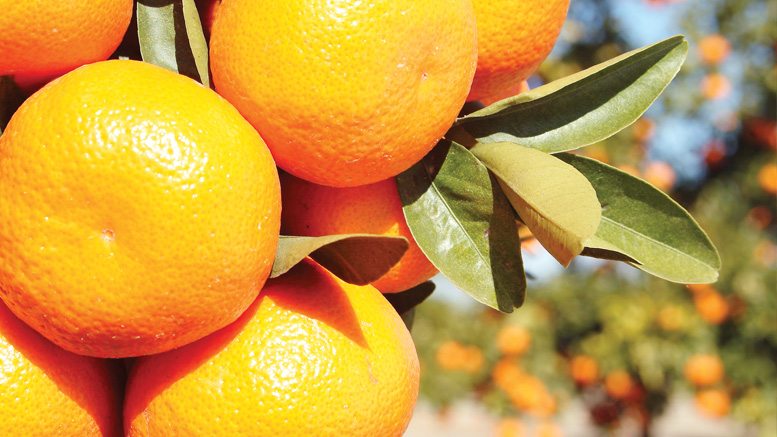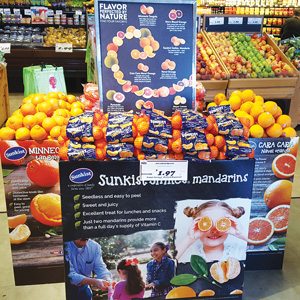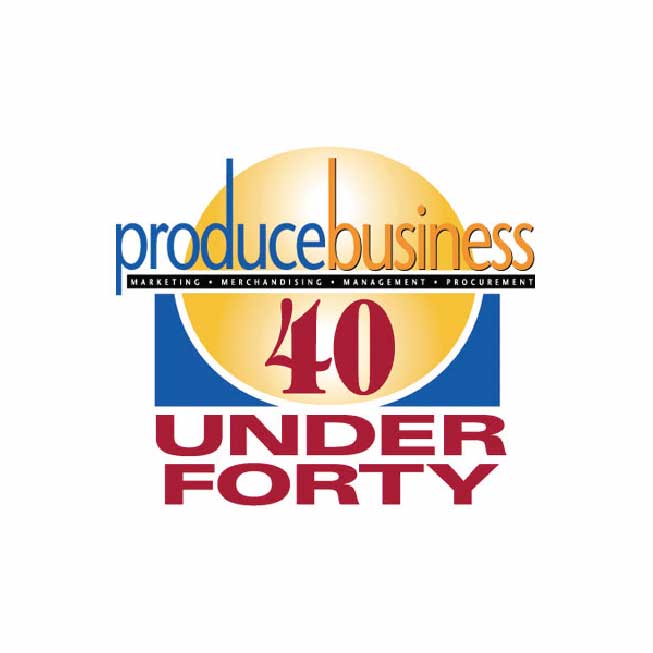California Citrus: More Popular Than Ever
November 15, 2017 | 10 min to read


Mandarins and Tangerines lead the way for a host of reasons.
Mandarins, Tangerines and other easy-peeler varieties continue their triumphant march through California’s great Central Valley, as they fit the bill for a nutritious, convenient fruit in a size suitable for a school child’s lunch box.
“Mandarins continue to hold high popularity amongst families everywhere,” says Monique Bienvenue, director of communications at Bee Sweet Citrus, Fowler, CA. “Their easy-to-peel quality and delicious taste make them the perfect on-the-go snack for work and school.”
Consumption of these convenient varieties has climbed steadily, from 2 pounds per capita to more than 5 pounds in 20 years, according to U.S. Department of Agriculture (USDA) statistics. And California farmers are not done increasing their production.
“The easy-peeler acreage is still coming up,” says Bob Blakely, vice president of California Citrus Mutual, Exeter, CA. “Navels are still Number One and are not dropping, but the Mandarins are certainly increasing at the expense of the Valencias. It is starting to level off at 60,000 acres of Mandarins; the 2016 survey had 59,000 acres of Mandarins.”
California produces 56 percent of the nation’s citrus crop by dollar value, according to the California Department of Food & Agriculture’s most recent statistical report (2015), and if there is anything new under the sunny skies of the Central Valley, it is the continuing development of varieties that will extend the season for easy peelers and specialty citrus varieties.
No Longer a Specialty
After per capita consumption of Mandarins and Tangerines doubled in just a decade, according to USDA statistics, grower-shippers jumped on the opportunity to make this fruit even more inviting and available over a longer period of time.
“Consumer demand for easy-peelers remains high, and specialty late season easy-peel varieties like Gold Nugget variety Mandarins and Ojai Pixie Tangerines offer consumers a different taste profile while also extending the season of this popular category,” says Joan Wickham, director of communications at Sunkist Growers, Valencia, CA.
As Mandarin sales continue to rise, growers are peeking over the fence as their neighbors work on the next big thing in easy peelers.
“You’re seeing a lot more Mandarins, and I think that trend will continue,” says Chuck Plummer, sales representative at LoBue Citrus, Lindsay, CA. “I hear through the grapevine that people are doing test plots on new Mandarins that will extend the season.”
Growers are also working on new varieties that will lengthen the season of other popular citrus specialties.
“People are looking to make the Blood Orange season extend later,” says Plummer. “It ends in the late spring, and they are trying to extend it. They are also extending the Cara Cara season.”
For some shippers, the development of new varieties has already extended the California easy peeler season.
“Murcott, Tango and other specialty Mandarin varieties have extended the California season into May,” says Bob DiPiazza, president emeritus of Sun Pacific Marketing, Pasadena, CA. “Late-season Washington, Barnfield and Powell variety Navel oranges have extended the California Navel orange crop into June/July.”
DiPiazza sees growing demand for, in addition to the Mandarins, a number of other specialty citrus varieties. “Cara Cara oranges, Clementine, Tango, Murcott and other specialty variety Mandarins like Gold Nuggets continue to grow in popularity,” he says. “And, we see real and growing interest in premium products like our Vintage Sweets Heirloom oranges and some resurgence in the popularity of Sweet Red grapefruit varieties. Lemons and limes have shown steady growth for a number of years with an occasional exception due to supply availability.”
Navels are still king in both acreage and pounds as the rise of easy peelers has come at the expense of Valencias, but this was a uniquely good year for this declining variety.
“This has been one of the best marketing years for Valencias in the past eight to 10 years; demand exceeds supply,” says Adam Flowers, account manager at Booth Ranches, Orange Cove, CA. “We start Navels around Oct. 15. We only ship Navels and Valencias.”
California Valencias benefitted this year from an unusually short Navel season and the later-than-usual arrival of imported citrus.
“We’re having a very good Valencia season,” says Citrus Mutual’s Blakely. “The Navel season was short, and the Valencia season came in before the imports. People tried them, and liked them. We’re seeing really good demand on California Valencias this year.”
The easy-peelers will begin shipping out of California in October and, with the season extenders, continue for eight months.
“Our Satsumas come in October, and the Clementines in November or late October,” says Blakely.
Flowers, too, has witnessed the long-term shift from Valencias to the ever more popular easy-peelers. “The easy-peeler used to be a specialty, but now it’s a commodity,” he says. “You have fewer people looking for large quantities of Navels.”
It’s a California Thing
Imported citrus offers slight competition for the California fruit, which remains the king of fresh market citrus.
“We have virtually no foreign competition with our easy-peelers,” says Blakely. “It used to be the Spanish Mandarins would compete, but not anymore. The imports are from Chile and Peru, and they’re counter-seasonal.”
The imports come largely when this fruit is not available from California.
“There are two distinct import periods for Mandarins,” says DiPiazza.
Those two periods are the summer, when imports arrive from the Southern Hemisphere and the United States is in its off-season, and the late fall to early spring when Spanish and Moroccan imports to the East Coast compete directly with U.S. citrus. “California has been capturing market share since the inception of the crop approximately 14 years ago, and holds about an 89 percent share of the production of U.S. grown Mandarins. California has grabbed predominant market share from Spain and Morocco, and the import volume today is dramatically less than 15 years ago.”
There are times, however, when the Southern Hemisphere season overlaps briefly with the California harvest.
“The imports will impact us into October,” says Roth. “They’ve got Mandarin varieties like we do, and Navels; lemons may be a factor next year. It’s a major factor on the East Coast because it costs as much as $8 to get a 40-pound box sent to the East Coast from California. We had a pretty good run this year because a lot of fruit was late in South Africa and Chile.”
Some shippers do fill in the gaps when California citrus is not available with a robust program of counter-seasonal fruit imported from the Southern Hemisphere.
“There are growers for citrus in all Mediterranean regions and most export,” says Limoneira’s Chamberlain. “Limoneira’s One World of Citrus model links our supply around the world with our global customer base so that we can assure our customers that they will receive supply continually throughout the year. We grow on 11,000 acres in California and Arizona, and have investments and partnerships in Chile, Argentina, Mexico, South Africa and New Zealand.”
The trucking industry reports shipments out of California continue to extend over longer periods of time during the year.
“Citrus has certainly been part of our growth in California freight,” says Jimmy De Matteis, president and chief executive of Des Moines Truck Brokers, Norwalk, IA. “As we have expanded our customer base we find ourselves delivering California citrus to different parts of the country than we did 10 years ago. The bulk of citrus we move still loads in the same areas of California — Salinas, Lodi, Coachella, to name a few. The heaviest volume is through the summer but the seasons have extended considerably. Oranges continue to be the highest volume of citrus we deliver. ” he says.
Displays That Work

Photo courtesy of Sunkist
New varieties have made the California citrus category more exciting than ever, and veteran shippers advise giving this fruit its due on the department floor.
“Build compelling waterfall displays front-and-center that shout, ‘Buy me!’ Four- to 12-foot-wide displays can all be effective; use available POS to call out the product and draw in the consumer,” advises Bob DiPiazza, president emeritus of Sun Pacific Marketing, Pasadena, CA. “Display contests capture the creativity and competitive spirit of your produce managers. A price that offers your customers good value is always a plus.”
One tempting strategy to reject is using citrus as breaks between different varieties of apples, pears or other fruit.
“Sunkist recommends retailers avoid using citrus as a color break. Create a citrus section that allows consumers to shop the category and explore the versatility of citrus,” says Joan Wickham, director of communications at Sunkist Growers, Valencia, CA.
Some grower-shippers offer assistance in developing displays and promotions.
“We think retailers know what’s best in terms of displaying product; however, we are always happy to provide supplemental marketing and POS material to those who think they’d benefit,” says Monique Bienvenue, director of communications at Bee Sweet Citrus, Fowler, CA.
One shipper has a robust promotion program designed to help citrus merchandising the entire year. “Each week we share Tasti-Tuesday tips with our grocery partners, who provide tips on how consumers can use citrus,” says John Chamberlain, director of marketing at Limoneira, based in Santa Paula, CA. “These short videos can be added to marketing efforts to give their shoppers additional uses. We offer a calendar of promotions that are complimentary and value-added for our grocery partners. We also offer our grocery partners free promotions monthly to help them sell more citrus.”
There is also little that is new when it comes to citrus packaging.
“A few companies are trying four to six smaller fruit in a clamshell, but the bagging is the same as it has been,” says David Roth, president of Cecilia Packing, Orange Cove, CA.
Aside from these experimental clamshells, citrus is bulked or bagged depending on the variety.
“Most major retailers are not selling bulk Mandarins; Mandarins are sold in mesh 2-, 3-, and 5-pound bags, and 5-pound boxes,” says DiPiazza. “Three pound bags and 5-pound bags and boxes are the most predominant. Very little is sold bulk. Navels are sold in 4-, 5-, 8- and 10-pound mesh or poly/mesh bags. And Navels are also sold in bulk. Generally, lemons, limes and grapefruit are sold both bulk and bagged. For oranges, 45 percent is loose, 55 percent is bagged. For lemons, 64 percent is loose, 36 percent is bagged.”
Shippers generally offer many sizes of bags for their easy-peeler varieties.
“We’ve noticed that the 2-, 3-, and 5-pound bags are the most popular for our Mandarins,” says Bienvenue. “There is not much bulk; most of our product is sold in bags.”
Rainy Days
After years of record-setting drought, heavy rains this past winter came as a welcome relief to California farmers, including citrus growers.
“We certainly needed the rain; it helped a lot,” says Bob Blakely, vice president of California Citrus Mutual, Exeter, CA. “Our growers will receive 100 percent water allotments this year. In some areas we got groundwater recharge.”
While recharge of groundwater that was pumped during the drought is good news in the long run, heavy storms may have reduced last season’s Navel crop.
“Last year was OK for Navels; we had a ton of rain, so it cut down on the yield,” says Adam Flowers, account manager at Booth Ranches, Orange Grove, CA. “The yields and harvest shouldn’t be affected this year.”
All that water looks to have also dampened the yields of this year’s California Valencia orange crop.
“I haven’t heard anyone say it’s going to be a really big crop of Navels this year,” says Chuck Plummer, sales representative at LoBue Citrus, Lindsay, CA. “The crop came up smaller than anticipated last season because of all the water and the affect seems to have trickled into the Valencias.”
While the long-range prognosis is good following the rains, the dampening effect may extend to this year’s Navel crop.
“This year’s crop could potentially be a little shorter,” says David Roth, president of Cecilia Packing, Orange Cove, CA. “We are thinking it will be 5 to 10 percent less than last year.”
Most of the rains also came north of the parched land that produces the lion’s share of the nation’s fresh market citrus, and water transfers to the Central Valley orchard remain politically charged.
“The rain was certainly welcome and needed, however, some of the heaviest rain occurred well to the north of the major citrus producing areas in the Valley,” says DiPiazza.
“We expect about the same size Navel crop, a larger Clementine crop, and because we harvested Murcotts into May, we expect that crop to be down slightly… but still a very sizeable crop.”
A wild card impacting the size of the harvest will be the effects of an unusually hot July in the Central Valley.
“There is concern about the extremely hot July we had, and whether it will lead to more summer drop,” says Blakely.
10 of 41 article in Produce Business November 2017

